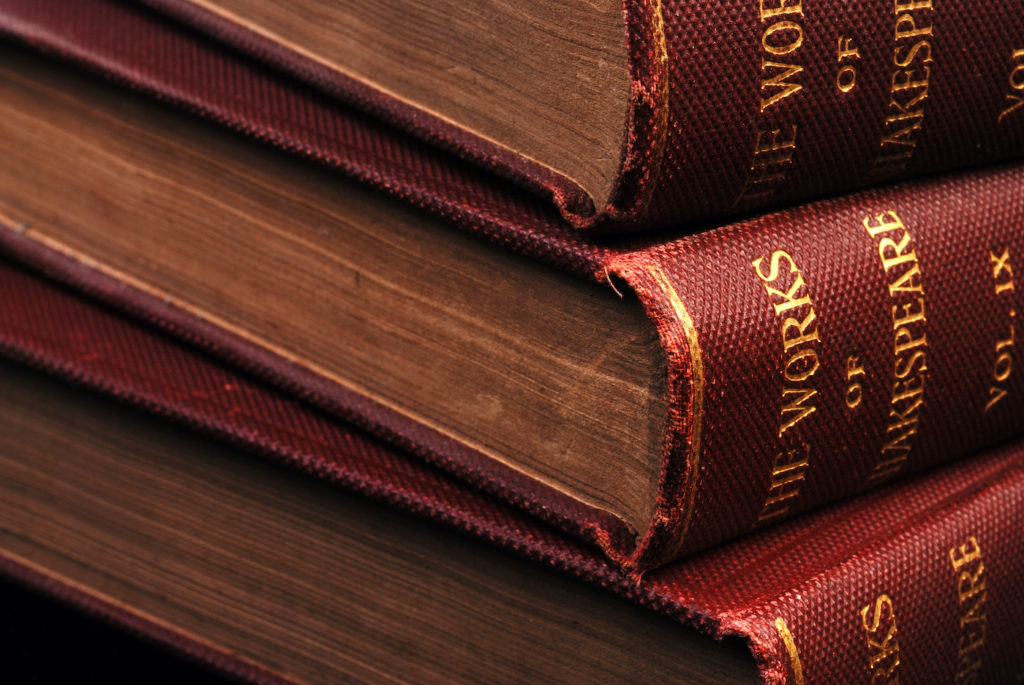No writer has ever made me feel so keenly my deficiencies as a reader more than William Shakespeare. (I will not be so ridiculous as to consider what Shakespeare tells me about my deficiencies as a writer.) In high school, I had to read one or two of his plays; in college he made his obligatory appearance in a survey of British literature; in graduate school I audited an English course wholly devoted to a generous sample of his work—with the predictable result of my neglecting to keep up whenever my for-credit work in political science demanded more attention. Along the way I also became aware of how seriously Shakespeare is taken for his insights into political life, by writers such as Allan Bloom, among others.
No writer has ever made me feel so keenly my deficiencies as a reader more than William Shakespeare.
But dipping into Shakespeare’s plays from time to time was unsatisfying; I grew ambitious to read all of his works. Yet how to proceed through it all? Some eight years ago, having read the Bible in its entirety a couple of times by using a daily reading plan that accomplishes the task in a year (something I may assay again, using the plan Serena Sigillito mentioned here a week ago), I thought it would be a great thing if someone had come up with something similar for reading all of Shakespeare’s works in a year. I looked high and low on the internet, however, and found nothing of the kind.
So I resolved to make my own daily reading plan for moving through all of Shakespeare’s works in a year. I first arranged it for my own use in 2013, and my friends at First Things published the plans for each year from 2015 to 2020. (They have been very understanding about my moving it here to Public Discourse beginning this year.) The version for 2021 is here.
Start your day with Public Discourse
Sign up and get our daily essays sent straight to your inbox.The plan takes a little revision on my part each year, because I decided to devote weekdays to the plays and weekends to Shakespeare’s sonnets and other poems. I have tweaked the plan in other ways as well. I revised it to move more quickly through the long poems read on Saturdays, Venus and Adonis and The Rape of Lucrece. And I decided after several years to deviate from reading the plays strictly in the chronology of their writing (as the authoritative Oxford Shakespeare prints them), in order to follow the English history plays in their historical chronology, beginning with Edward III and ending with Richard III.
Reading time each day is a half hour or less. For ease of use without worrying about where one’s large one-volume Shakespeare is, I recommend an electronic version of his works, readable on a phone or tablet. (Some people may prefer a set of portable paperbacks, also a good choice, but the cost adds up.) The Oxford Shakespeare is available in a Kindle version, but not in what I would call a very reader-friendly format. In recent years I’ve instead used the Shakespeare Pro application on my iPad (it has both Apple and Android versions), and found it a much better reading experience. But it necessitates the inclusion of some alternate scene divisions in the plan (which users will see pretty clearly marked).
Since I began to offer this plan online to other readers, one of the most interesting reactions I have experienced is that some people have begun to treat me as some kind of expert on Shakespeare. But I created the plan for reading all his works in a year precisely because I am not an expert, and I sought a way into a full immersion in his works. Neither have I employed the plan consistently myself, year in and year out; I’ve undertaken the annual revisions because there are always people asking me for the update. I plan to read straight through the works in 2021, but I may not make it, and that’s okay too. If I manage it, this will be only the third or fourth time completely through for me. Certainly my puny efforts so far do not make me any kind of authority on Shakespeare!
Shakespeare’s plays were written to be performed, but in these pandemic days the live theater is shut down almost entirely. There are many good film versions of some of the plays, however, and it’s good to see them and not just read them. Here are a few.
The history plays have been brought to film by Laurence Olivier, starring in and directing Henry V and Richard III, by Kenneth Branagh, starring in and directing Henry V, and by a high-powered cast including Jeremy Irons, Tom Hiddleston, and Benedict Cumberbatch in the 2012 series The Hollow Crown, which assembles the story from Richard II to Richard III.
Olivier also directed and starred in Hamlet, and played Othello (available on disc but not streaming), the latter also brought to film by Orson Welles as both star and director, and yet again in the 1990s with Laurence Fishburne as the moor of Venice and Kenneth Branagh as Iago. If you can’t get enough of Hamlet, there’s also a 1969 version directed by Tony Richardson with Nicol Williamson as the prince of Denmark, a 1989 Franco Zeffirelli version starring Mel Gibson (on disc but not streaming), and Branagh’s uncut version from 1996. Branagh also directed and starred in an excellent film of Much Ado About Nothing, playing Benedick opposite his then-wife Emma Thompson’s Beatrice.
In addition to Hamlet, Zeffirelli also directed lush, beautiful versions of The Taming of the Shrew and Romeo and Juliet. In 1980, John Cleese took a turn as Petruchio in a filmed stage production of the Shrew for the BBC. For versions of Macbeth, see Nicol Williamson play the thane of Cawdor in the 1980s, and a modern-setting version with Patrick Stewart from 2010. And I’m not parting with my home-recorded DVD of the great Paul Scofield as King Lear in 1971, because it seems you can’t watch it anywhere else today.
There are far more films of Shakespeare’s plays than I can mention here, but I’ll recommend just one more: the magical 1935 version of A Midsummer Night’s Dream, directed by Max Reinhardt and William Dieterle. Its all-star cast included James Cagney, Joe E. Brown, Frank McHugh, and Dick Powell—none of them typically “Shakespearean” actors—plus 15-year-old Mickey Rooney (already a Hollywood veteran) as Puck, and 19-year-old Olivia de Havilland in her film debut as Hermia. Dame Olivia died this past July at 104. Here in her first movie, you can glimpse the great talent she would reveal over many years to come.
Happy reading—and viewing—in 2021!














